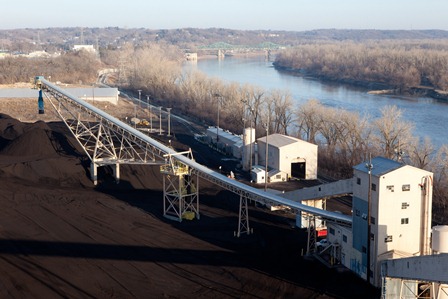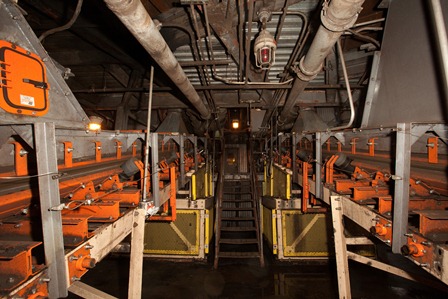Upgrades At Omaha Public Utilities
Published: August 17th 2012
 [Omaha, NE] - The Omaha Public Power District (OPPD) is one of the largest publicly owned electric utilities in the United States, serving more than 350,000 customers in 13 southeast Nebraska counties. Employing 2,300 people, it operates over 15,500 miles of electric transmission and distribution lines. Organized as a political subdivision of the State of Nebraska in 1946, today the OPPD has a generating capacity of over 3,200 Megawatts, almost half of which is generated from coal.
[Omaha, NE] - The Omaha Public Power District (OPPD) is one of the largest publicly owned electric utilities in the United States, serving more than 350,000 customers in 13 southeast Nebraska counties. Employing 2,300 people, it operates over 15,500 miles of electric transmission and distribution lines. Organized as a political subdivision of the State of Nebraska in 1946, today the OPPD has a generating capacity of over 3,200 Megawatts, almost half of which is generated from coal.
In the 1980s, as part of OPPD’s commitment to best environmental stewardship practices, the North Omaha Power Station, a 646 Megawatt coal fired power plant located on the Missouri River north of the city, was converted to burn cleaner, lower sulfur coal from Wyoming’s Powder River Basin (PRB). Constructed over 50 years ago, the five-unit plant was initially designed to burn Midwestern produced high sulfur coal. Though now cleaner, during the initial conversion process, the plant was not fully optimized to address the particular dust mitigation techniques necessary when handling PRB coal.
While containing less sulfur, PRB coal contains more water, generates less heat and burns less efficiently than the type of coal it replaced. In fact, though overall emissions have been reduced, the plant now requires more through-put to ensure the same generating capacity. Even more vexing, due to several of the inherent properties of PRB coal, it is prone to sudden, spontaneous combustion (spon-com). Controlling spon-com is both time consuming and frustrating. One could perfectly control the coal’s temperature, prevent sparks and flames from hitting it and it could still just start burning on its own. On top of that, the coal easily breaks down into tiny highly flammable dust particles that, if left untreated, can float in the air and potentially ignite.
Adjusting material handling flow to the characteristics of PRB coal and addressing its unique safety hazards led OPPD to seek Martin Engineering’s expertise. Several years ago management at OPPD started taking steps to prepare the plant to become a leader in PRB safety handling. OPPD took these steps because they knew better coal handling ensures a more productive plant, safer and healthier employees, and more consistent production.
“Our plant puts an extremely high dollar value on safety. We have 120 employees here, and our recordable injury frequency rate is extremely low. We’re not gamblers here. We demand that our employees work safely, and it’s our job to ensure that each of them has a healthy and safe environment to work within. That way everybody wins. I see OPPD and Martin working together in a dust mitigation and safety partnership for many years to come,” said Kirk Estee, P.E. Material Handling Supervisor at OPPD.
OPPD was using a conventional, dated materials handling system. Martin, who already had a long service history with the North Omaha Station, was asked to conduct a safety and materials handling audit specifically addressing fugitive dust and overall coal dust control. After walking down the belts and conveyors, reviewing the chutes and other coal handling facilities, Martin employees immediately began to take note of how and where they could make a large difference to the overall safety of the plant. Within a few weeks, OPPD and Martin developed a multi-year improvement plan to ensure a safer dust environment. OPPD initiated a multi-phase project aimed at combustible dust mediation. As management requested proposals on the first scoped project, they determined that whichever vendor was awarded the first project, that equipment would be standardized. OPPD did not want to have three to four different vendors stocking similar materials and confusing employees.
After walking down the belts and conveyors, reviewing the chutes and other coal handling facilities, Martin employees immediately began to take note of how and where they could make a large difference to the overall safety of the plant. Within a few weeks, OPPD and Martin developed a multi-year improvement plan to ensure a safer dust environment. OPPD initiated a multi-phase project aimed at combustible dust mediation. As management requested proposals on the first scoped project, they determined that whichever vendor was awarded the first project, that equipment would be standardized. OPPD did not want to have three to four different vendors stocking similar materials and confusing employees.
“Martin has been very responsive from an RFP standpoint. Throughout our on-going relationship, they’ve been very responsive the whole way, giving us competitive pricing, standing behind their product and ensuring that they operate reliably,” said Estee.
The project started with the first installation beginning in Oct. 2009 and completed over four phases, finishing in 2012 and included transfer point upgrades to twelve belts throughout the plant and installation of insertable air cleaners to 10 load zones.
Martin Engineering supplied components to contain material and improve serviceability. Belt support cradles were installed under the drop chutes to absorb impact and stabilize the belt lines and prevent spillage.
Martin then installed Martin® insertable Air Cleaners on the load zones to further reduce the escape of fugitive material. Rather than carry dust-laden air to a central collector, insertable systems filter the air inside the transfer point where they can easily return material to the conveying system.
An integral fan pulls dust-laden air through the filter elements. The air passes through the filter, leaving the particles on the filter element. Each filter element is then regularly cleaned by a “reverse jet” of compressed air, which is injected into the filter element. This causes a momentary reversal of the air flow dislodging the dust cake back into the main material body.
Installation of insertable air cleaners will eliminate many of the problems seen with central “baghouse” collection systems, including long runs of ducting, large enclosures, maintenance difficulties and high power consumption. Insertable filters are integrated into the transfer point enclosure, where they can easily return material to the conveying system.
Additionally, Martin installed a Dust Fighter™ Foam system to further reduce fugitive dust. The foam system mixes and applies consistent dust suppression foam to the load to control airborne dust while minimizing the addition of moisture to the material. The foam system consists of a cylinder with inlets for the lines carrying air and the chemical/water mixture and outlets to accommodate up to 8 nozzles. Duckbill nozzles are set in a cam mechanism that allows the nozzle to be removed from the chute for maintenance without requiring any tools.
The system architecture allows the system to be easily automated by including electrical ball valves in the water line at the inlet of the pump module and at the air inlet of the foaming chamber.
The new Martin dust collectors have allowed the North Omaha Station to become safer “because now that we can use the smaller Martin products, we can shut down the older, larger dust collector that has a history of explosion hazards. The little ones don’t contain, capture or store large amounts of fuel. They just have a few ounces of coal in them at any time, and they’re always purging and cleaning themselves. From a safety standpoint, that’s why they’re great,” said Estee.
The new insertable air cleaners are only one part in a larger dust mitigation strategy that includes dust containment and other fundamental practices that Martin advocates. “The air cleaners are icing on the cake. The insertables are a safer way to do the dust collection. But maintaining and understanding Martin’s dust control foundations is the most important change we’ve made on this front,” said Estee.
Overall, the biggest dust control improvement has been the rebuilding of the coal transfer points to contain that dust. “We used to have lots of dust and spillage. But now that almost all the transfer points have been rebuilt, it’s a night and day difference. The majority of the continued spillage is due to other operational problems that are being addressed,” said Estee.
To help ensure that all the transfer points are working properly, Martin comes to the plant monthly, walks through the belt lines and transfer points. Technicians replace the various wear items, adjust the belt cleaners and ensure that proper tension levels throughout the coal handling conveyor system are maintained. Martin also keeps a parts inventory on site that they withdraw from as needed. If a new seal, belt cleaner or other item is needed, it is close at hand.
Given Martin’s history and longevity, OPPD management knows they can trust Martin for the long haul. “When Martin’s personnel go through every month, they’re going through looking at their own equipment that they installed. Because they are familiar with our system, they’re able to quickly and efficiently diagnose problems as they arise,” said Estee.
“They come in, install product for you, and return not only to ensure that the system is working properly, but they take it upon themselves to look for problems. Because we don’t have the time to study all the inherent challenges posed by dust control, Martin makes sure that everything is working as promised,” said Estee.